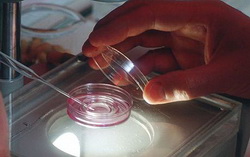In Vitro Fertilization or IVF is a process that involves artificially joining the sperm and the egg cell outside the female body. IVF treatments are made available to couples with either an infertile male partner or a barren female partner. When couples are identified with having problems with fertility or they have not yet conceived after more than 3 years of trying, then they will go through a series of tests before undertaking artificial fertilization.

How IVF treatments are done
The patients eligible to undergo IVF treatments are generally provided with fertility drugs in order to stimulate the ovaries to produce a number of mature eggs for fertilization. The patient has the option not to take the drugs but the odds of being pregnant are higher with more eggs. The doctor will be the one to decide the combination of fertility drugs that will be appropriate for the patient.
There are other fertility specialists that find the process of taking complete control of the menstrual cycle as the best option and initiate treatment by making use of drugs known as GnRH or gonadotrophin-releasing hormones which suppresses the menstrual cycle. This is commonly taken as an injection or nasal spray.
These are then followed by hormone injections to stimulate ovulation. These could be hMG or human menopausal gonadotrophin and hCG or human chorionic gonadotrophin. The patients are closely monitored while they are taking these drugs since different patients have dissimilar responses to the drugs. While some may only experience mild side effects, others may have adverse reactions.
The monitoring process helps the doctor in detecting if the eggs have already matured. The ultrasound scan will be used to confirm whether the eggs are ready to be retrieved. When retrieval date has come, the patient will be given sedative anesthetic which will render the patient sleepy but conscious. The doctor will then remove the matured eggs from the ovaries with the use of a fine, hollow needle. Another ultrasound scan guides the doctor to the right location of the matured eggs.
During the same time of the retrieval of the eggs, the male partner will provide a fresh sample of his sperm. Another option is to use donated sperm which has been preserved in the freezer. Whichever option is used, the sperm cells are washed and those with superior quality are taken to fertilize the eggs. The sperm cells are combined with the eggs in a laboratory dish that contains nutrient medium. Afterwards the eggs and spermatozoa in the laboratory dish are cultured in the incubator.
Techniques to increase chances of success of IVF treatments
In theory, IVF could be done even with natural ovulation only, that is, without the use of hormone supplements. The egg from the uterus or fallopian tube of the woman is removed with the use of a plastic catheter. The egg is then mixed with the sperm of the male partner then reinserted back into the uterus of the woman. But if there are no additional techniques, the chances of a fruitful pregnancy can be pretty slim. The techniques regularly employed with IVF treatments include the use of hormonal drugs to stimulate the ovary to produce multiple mature eggs, oocyte retrieval straight from the ovaries guided by transvaginal ultrasound, proper preparation of egg and sperm, and culture and selection of healthy embryos.
